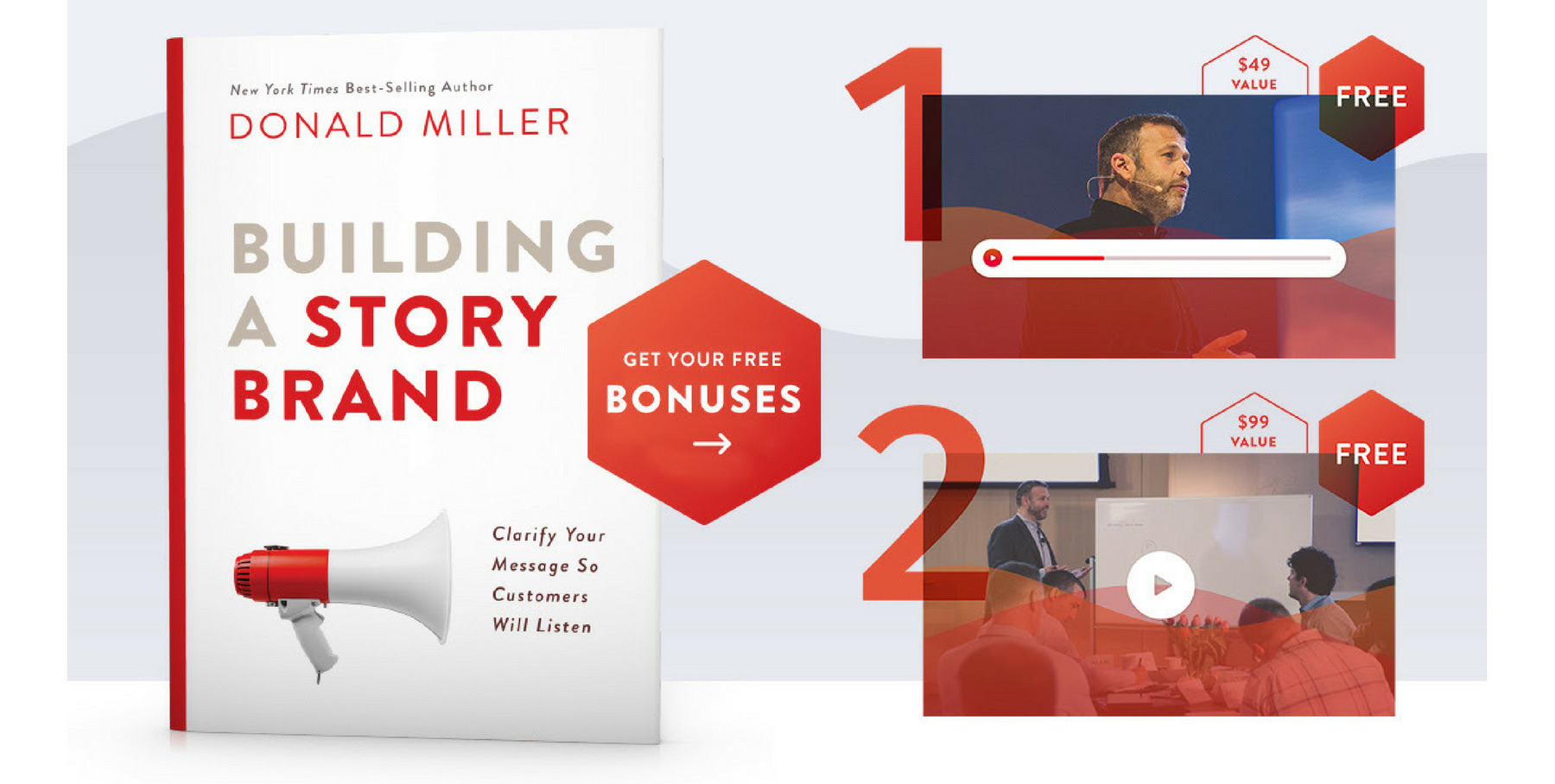
Episode Description
This week my new book Building a StoryBrand is out! If you’ve been wanting to clarify your message pick it up today at Amazon or Barnes & Noble!
That said, if you don’t want to order it because reading hurts your brain (several scientific studies have proven this to be true), there’s a distant, distant second option I recommend. And that’s to listen to this week’s podcast and read this blog. This week, J.J. and I shamelessly plug the book by going through it point by point. It’s like the audiobook but with a laugh track!
Consider this blog the show notes for the episode, and for that matter, the book.
The main reason I wrote the book is because I WANTED TO MAKE MARKETING EASY and I believe it accomplishes that task.
In fact, the subtitle I proposed for the book was “The Last Book About Marketing You Will Ever Need.” The publisher told me it lacked humility. I said it’s hard to be humble when you’ve written a book this good. They didn’t say anything after that.
Anyway, here’s a summary of several of the principal points in the book. The best points, though, you’ll have to buy the book to get. I’m no dummy. Anyway, I hope you read these ideas, apply them and make loads of money. And I hope they make you want to buy the book to make even more.
Story is the most powerful tool in the world to captivate the human brain. When you learn to use story in your brand’s communication, your customers will finally pay attention to what you’re saying. You can learn to use story to clarify your message. Here’s what I’m talking about:
Each story starts with a…
#1: A Character
Every story begins with a character who wants something. In movies, screenwriters identify the hero at the start of the movie and, within minutes, the audience knows what they want.
For example, if 12 minutes into The Bourne Identity the audience still doesn’t know exactly what Jason Bourne wants, they’re going to walk out.
Most companies aren’t clear in explaining what they offer. When you define something your customer wants, you invite them into a very specific story. And that’s what they’re looking for; they’re looking for you to invite them into a story.
While I explain this thoroughly in my book, the short version is that you must summarize what you offer in just a few words. If you throw out multiple solutions to multiple problems, you’ll be ignored. The human brain just isn’t made to process that many storylines.
You have to be known for something, preferably one thing.
Ask: What do my customers want as it relates to my brand? Is my brand known for one thing it offers?
#2: Has a Problem
Do you remember the old Rolodex files that sat on people’s desks? The ones that held business cards?
People have a Rolodex file in their brains. And when they hear about your business, they don’t file your business alphabetically — they file your business under the problem you solve.
If you haven’t clearly defined the problem you solve, they’re going to throw your business card away.
The only reason people are calling you, going to your website, or walking into your retail store is because they have a problem and they need you to solve that problem.
When you define that problem for your customers and offer to resolve it, they’re interested.
Ask: Have you clearly defined the problem your brand solves?
#3: And Meets a Guide
This is a big paradigm shift.
Customers aren’t looking for a hero. They’re looking for a guide.
If you understand this important principle, you’ll change how you talk about your business.
Potential clients don’t need another hero. They need a guide.
In chapter 6 of the book, I describe in detail how to position yourself as a guide. But, the first step is understanding your role in your customer’s story:
- • You’re not Luke Skywalker. You’re Yoda.
- • You’re not Katniss. You’re Haymitch.
- • You’re not James Bond. You’re Q.
So, when your customers come to you, don’t talk about what you’re trying to do. Lay out your products and services as weapons that will help them save the world, get the girl, or win the day.
That’s the message they respond to.
Ask: Are you positioning yourself as the guide?
#4: Who Gives Them a Plan
Let’s recap:
- You’ve identified what your customer wants, which invites them into a story.
- You’ve identified a problem that makes them feel something which hooks them into the story.
- You’ve positioned yourself as a guide so now there’s some hope they can solve their problem.
You’ve done well. This is farther than most companies get with their customers, but it’s too soon to ask them for the sale.
If you ask for the sale now, your customer can only see a yawning chasm between where they are and where they need to go. Pulling out their wallet is scary. If they spend money, they might lose money. If it doesn’t work, they may be embarrassed.
How do you overcome this? You need to give your customers a plan. Just three or four steps that explain how easy it is to work with you.
For example, a financial advisor might say,
I think you can probably retire earlier than you thought. I have a really easy process that helps you to make that decision.
- We meet for an informal meeting.
- We assess your goals.
- You get a customized strategy to retire early. If you choose, I can help you execute that strategy for the rest of your life.
When you give your customers a plan, you’re helping them overcome the barriers to their success. Because this element is so important, there’s much more information about it. In chapter 7 of the book, I outline two different plans that you can choose from. And remember, since you’re the guide, you’re going to have to outline a plan so your hero can win the day.
Ask: Do you have a simple plan that makes it easy for your customers to do business with you?
#5: And Calls Them to Action
Finally, the time has come to ask for the sale. Here’s something to remember:
Customers don’t take action unless they are challenged to take action.
As the guide in your customer’s story, you must challenge them to buy something from you and this challenge must be very, very clear.
If there’s not a Buy Now button in the top right corner of your website, you’re losing sales. Do not crowd that section of your website with 25 other choices like About, Contact, and FAQs. Your direct call to action (the Buy Now button) should be a different color and it should be the obvious button to press.
In chapter 8 of my book, I give you clear instructions on how to arrange the call to action on your website and I also talk about another call to action that helps your customer stay in relationship with you even if they’re aren’t ready to buy right away.
We have to give our customers something to accept or reject.
Ask: Do you have a clear call to action?
#6: That Helps Them Avoid Failure
This is a classic piece of storytelling. Heroes are compelled into action because something is at stake.
- • Katniss volunteers for the Hunger Games to save her sister, Prim.
- • A retired CIA officer must use all his past connections and skills to rescue his daughter from an abductor in Taken.
- • Michael is thrust into his father’s world of the mafia when his father is shot in The Godfather.
None of these characters wanted to engage in the action of the story. They were compelled to in order to avoid a tragic ending (failure).
In the book, I describe how every customer is trying to avoid a tragic ending, too. What that means for your brand is you must clearly communicate the negative consequences of what will happen to your customers if they do not buy your products or services.
Ask: Have you communicated what’s at stake to your customers? What are the negative consequences of not doing business with you?
#7: And Ends in a Success
You need to show customers how your products can positively affect their lives.
Both your website images and your sales copy should help your customers envision life with their problems solved. Show them what their life can be like without a toothache, with more money in the stock market, with their lawn looking amazing, or loving the way those clothes feel or fit.
People naturally steer toward a happy ending.
An excellent example is booking.com. Competing with Travelocity, Priceline and Hotwire, they set themselves apart from their competitors by focusing on one thing: displaying success over and over.
You’re going to like your trip, your hotel room, the food, the plush carpet, the weird yoga class, your whatever. You’re going to love your vacation.
People started booking there because they wanted to have that incredible experience.
If you’re not telling people what their life will look like when they do business with you, they’re not going to do business with you.
Ask: How can you help your customer envision success after doing business with you?
__
You’ve just received a tiny taste of the StoryBrand 7-Part Framework and how you can apply the elements of story to your business. If you’re not using these elements in your marketing, you’re contributing noise to the marketplace rather than giving people a narrative they can step into.
A clear message is your competitive advantage. If you fumble over your words and ideas, and you don’t know exactly how to communicate what you do, you’ll confuse your customers and people won’t buy your products. But by using the 7 elements of story, you’ll be communicating a clear message that customers will hear and respond to.
If you enjoyed this blog post, you are going to love my new book. I thoroughly explain each of the 7 parts of the StoryBrand Framework and give you tangible next steps so you can experience growth in your business. Buy the book today on Amazon, Barnes and Noble, or iBooks.

LAST CHANCE TO GET TWO FREE BONUSES
Don’t cut your profit short.
You’ve gathered a lot of valuable information by reading, but there’s so much more! Buy the little book that makes marketing easy. If you act now, you’ll get two amazing bonuses:
- The Secret to How Customers Think (Audio Lecture, $49 Value)
- Why Customers Really Buy (Video Lesson, $99 Value)
Getting the bonus content is really easy!
Simply (a) purchase the book from any retailer and (b) forward your receipt to bonus@StoryBrand.com.










